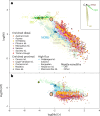A common precursor for global hotspot lavas
- PMID: 39399208
- PMCID: PMC11464371
- DOI: 10.1038/s41561-024-01538-7
A common precursor for global hotspot lavas
Abstract
Hotspot lavas exhibit chemical heterogeneity, much of which is ascribed to heterogeneous deep mantle sources that contain various components with distinct composition, origin and age. However, characterizing primary melt compositions and mantle heterogeneity directly is challenging. Here we investigate a global dataset of hotspot lavas to constrain the incompatible-element composition of their parental melts and sources. Trace-element ratios indicate that the compositional heterogeneity of global hotspot lavas is not primary, but reflects processes that hotspot melts undergo as they ascend to the surface. We find the parental melts of these lavas, as well as of kimberlites and basalts from large igneous provinces, to be uniform in their elemental, and radiogenic and noble-gas isotope, composition. We suggest that the parental melts to all of these lavas derive from a depleted and outgassed mantle reservoir that was replenished with incompatible element-enriched material during the Archaean. This interpretation explains the elemental, radiogenic and noble-gas isotope compositions of hotspot lavas without requiring a heterogeneous lower mantle or the long-term survival of undegassed relics from a primordial Earth.
Keywords: Geochemistry; Geology; Petrology.
© The Author(s) 2024.
Conflict of interest statement
Competing interestsThe authors declare no competing interests.
Figures




References
-
- Boyet, M. & Carlson, R. W. 142Nd evidence for early (>4.53 Ga) global differentiation of the silicate Earth. Science10.1126/science.1113634 (2005). - PubMed
-
- Toboul, M., Puchtel, I. S. & Walker, R. J. 182W evidence for long-term preservation of early mantle differentiation products. Science335, 1065–1069 (2012). - PubMed
-
- Hofmann, A. W. & White, W. M. Mantle plumes from ancient oceanic crust. Earth Planet. Sci. Lett.57, 421–436 (1982).
-
- Allègre, C. J. Isotope geodynamics. Earth Planet. Sci. Lett.86, 175–203 (1987).
-
- Zindler, A. & Hart, S. R. Chemical geodynamics. Ann. Rev. Earth Planet. Sci.14, 493–571 (1986).
LinkOut - more resources
Full Text Sources
